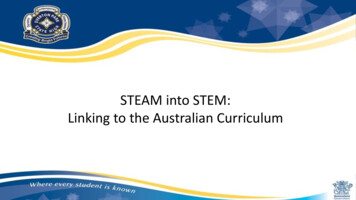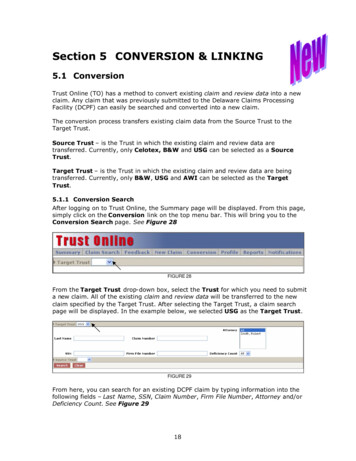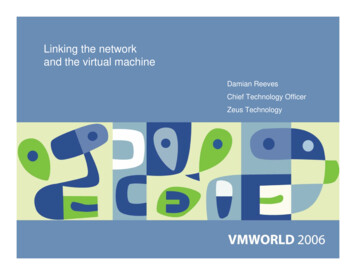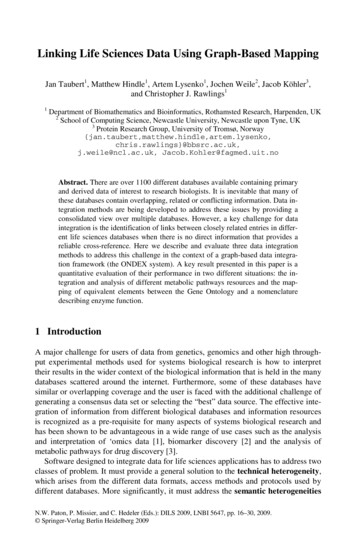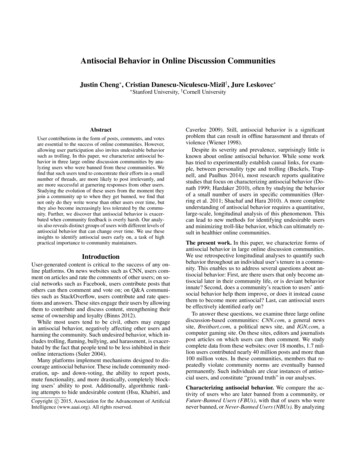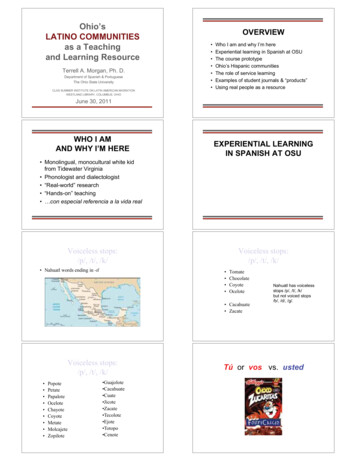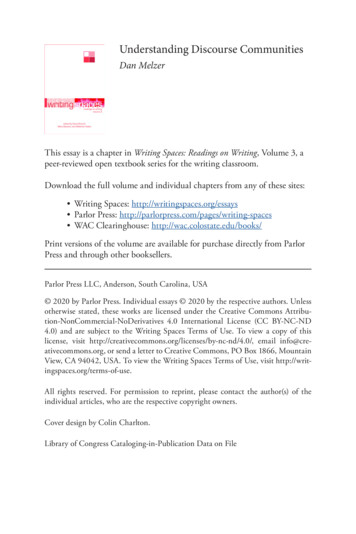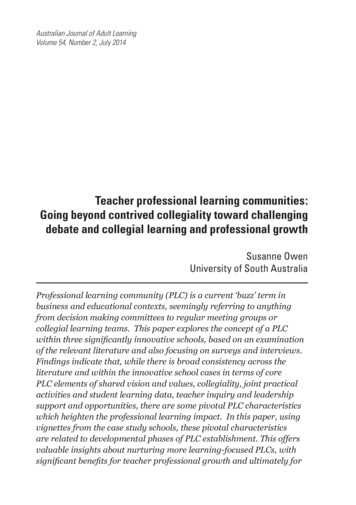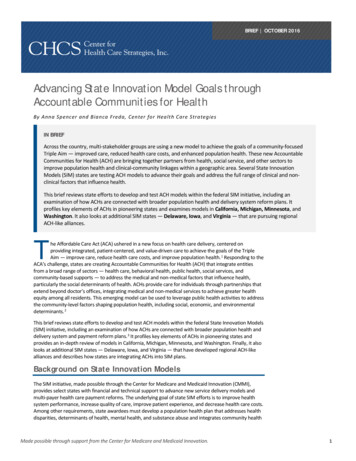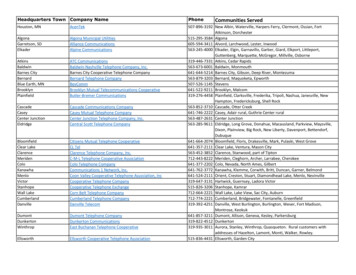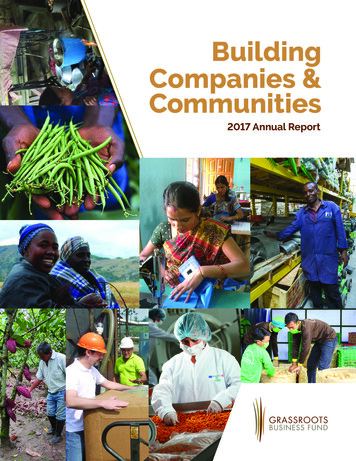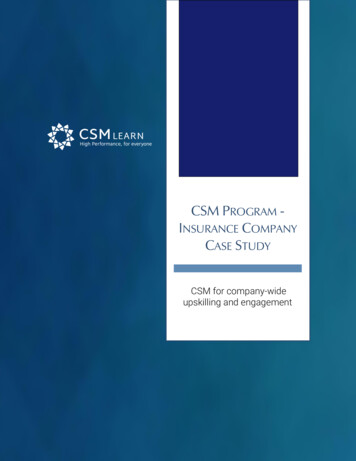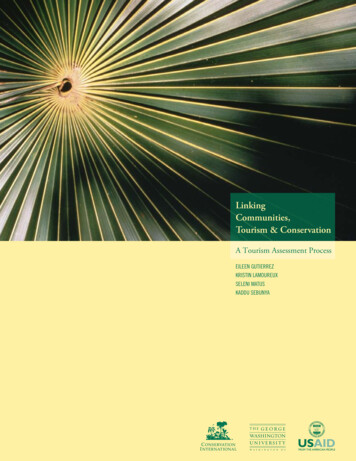
Transcription
LinkingCommunities,Tourism & ConservationA Tourism Assessment ProcessEileen GutierrezKristin LamoureuxSeleni MatusKaddu SebunyaIntroduction
AcknowledgementsMany thanks to our official reviewers who provided extensive input and alternative views: Sylvie Blangy, Board of Directors, The International Ecotourism Society;Allison Rossetto, James Cook University;Donald E. Hawkins, George Washington University.Additionally, much gratitude to Stephen Edwards for his early input on the overallframework and approach; as well as, Edward Millard, Megan Havdra, Susan Kennedy,Scott Wayne, and Janet Edmonds for their constructive comments and assistance.Finally, this publication would not have been possible without the encouragementand support from Edward Millard and Fred Boltz of Conservation International andRoberta Hilbruner of the United States Agency for International Development ‘sSustainable Tourism Program.All photos copyright Conservation International unless otherwise noted. Cover image by SantiagoCarrizosa. Haroldo Castro: Inside Cover, Pages 11, 31, 55, 69, 97, 113, 118 & 119; Jeff Gale: Tableof Contents, pages 7, 23, 47 & 102; Patrick Johnston: Preface; Emilia Hillel: Pages 5, 8 & 17; PiotrNaskrecki: Page 9; Cristina Mittermeier: Pages 10, 89, 90 & 100; Nico Van Strien/IRF: Page 13; BillKonstant: Page 15; Russell Mittermeier: Pages 15, 22, 30, 39, 56, 57, 63, 71; Tom Lamb/Lamb Studios:pages 20, 25 & 45; Darwin Flores: Page 26; Theo Allofs: Page 29; Michael Poliza/Gudigwa Camp: Page 37;Frank Stewart: Pages 46 & 48; Patricio Robles Gil: Pages 65, 93, 99, 103 & 106; Chris Brooks: Page 66;Chen Qi: Page 71; Haroldo Palo, Jr: Page 73; Roger Steene: Page 91; Michael Poliza/Gudigwa Camp: Page94; Susan Kennedy: Page 101; Roderic Mast: Page 102, 103; Lani Asato: Page 107; Donovan Kirkwood:Page 111; Olivier Langrand: Page 114; Toby Marsden: Page 115; Gustavo Fonseca: Page 116. 2005 Conservation International and The George Washington UniversityCopies of this publication in whole or in part are permitted as long as a copy of the title page and this copyright page accompany said copies.Conservation International is a private, non-profit organization exempt from federal income tax undersection 503(c)(3) of the Internal Revenue Code.The George Washington University is a federally chartered non-profit institution.This report was partially funded by the United States Agency for International Development. The author’s views expressed in this publication do notnecessarily reflect the views of the United States Agency for International Development or the United States Government.Graphic Design: Frank Stewart, Cautiontiger Graphic DesignCopy Editor: Tracy Ilvento, Applied Business Communications, Inc.ISBN 1-881173-43-7
PrefaceLinking Communities, Tourism and Conservation – A Tourism AssessmentProcess has been designed by Conservation International (CI) and The GeorgeWashington University (GW) for field practitioners to perform a rapid assessmentand analysis of tourism potential in a destination. The guidelines and tools providedare research-based and reflect accepted criteria and principles of sustainable andecotourism development. It incorporates sustainability concepts that aim tooptimize tourism development in an effort to protect natural and socio-culturalresources and improve the welfare of local people, while enhancing monetary gainsand market access. This hands-on manual is also a tool for practioners engaged inapplying tourism as a strategy for biodiversity conservation and poverty reduction.Conservation International and The George Washington University have successfullyemployed many of the concepts presented in Linking Communities, Tourism andConservation – A Tourism Assessment Process in developing destinations around theglobe. These concepts are based on a culmination of over 25 years of field experience inconservation and tourism development between both organizations and their partners.The Tourism Assessment Process (TAP), outlined in this manual, addresses the complexities of tourism at both the national and local levels. While the authors acknowledge the importance of applying sustainable and ecotourism tourism principles toall scales of tourism development, this assessment tool focuses primarily on tourismdevelopment at a destination or site rather than a specific business or venture.Assessment Teams comprised of technical specialists working within or near highbiodiversity areas and rural communities will guide this highly participative assessment process. These multidisciplinary teams should be joined by an experiencedtourism development specialist and include community extensionists, economistsand other development specialists, parks and protected area personnel, government officers, educators, non-governmental and private sector organizations. Itis assumed that users have some basic knowledge of ecotourism and sustainabledevelopment, experience in conducting primary and secondary research, as well asexperience working with a range of stakeholders on a coordinated effort. The TAPis also designed to involve local stakeholders with or without tourism experience.The goal of Linking Communities, Tourism and Conservation – A Tourism AssessmentProcess is to help you determine whether a destination is suitable or unsuitable for sustainable tourism. Specifically, this hands-on manual will help you assess a destination’stourism potential, both negative and positive impacts to biodiversity, as well as impactson social, cultural and resource needs. The key that opens the door to this clearer viewof a destination’s tourism potential is the Tourism Assessment Process (TAP).
Table of ContentsIntroductionAssessment Process Overview46Integrating the Assessment Process6Building the Tourism Assessment Team6Tourism Assessment Process – Three Phases to Success 7Phase I Assessment Preparation12Initial Data Collection12Understanding Environmental, Biodiversity & Natural Resource Issues13Identifying Land Use Plans and Zoning 15Phase II AssessmentInvolving Local Stakeholders1618Methods for Involving Community Stakeholders 20How to Host Public Meetings and Workshops 20Generating Dialogue from a Visioning Exercise 21Using Individual Consultations 22Selecting Assessment Participants 22Tool: Tourism Destination Visioning Exercise 24Tool: SWOT Analysis 26Attractions Inventory28Components of the Attractions Inventory 28Conducting the Attractions Inventory 29Worksheet 1: Natural Attractions 32Worksheet 2: Cultural Attractions 33Worksheet 3: Historic and Heritage Attractions 34Worksheet 4: Recreational Activities 35Worksheet 5: Inventory Evaluation Sheet 36Infrastructure and Services38Identifying Opportunities and Overcoming Obstacles 38Worksheet 6: Transportation 40Worksheet 7: Accessibility Summary 41Worksheet 8: Public Services 42Worksheet 9: Evaluation of Surroundings 43Market Demand Analysis44Sources for Conducting Market Demand Research 44The Value of Conducting Visitor Surveys 45Understanding Market Segments 46Estimating Market Size 47Tool: How to Design a Questionnaire 49Tool: Sample Visitor Questionnaire 50Tool: Conducting a Visitor Survey 52Tool: How to Analyze and Interpret Survey Results 53Supply and CompetitivenessUnderstanding the Supply-side of Tourism 54Defining the Competition 5554
Surveying the Tourism Industry 55Competitiveness and Sustainability 57Worksheet 10: Competitive Advantage Exercise 58Tool: Sample Accommodation Facilities Survey 60Tool: Sample Tour Operator Survey 61Tool: Sample Arts and Crafts Enterprise Survey 62Human and Institutional Capacity64The Process of Mapping Available Human Resources 64Developing a Labor Force Profile 65Assessing Institutional Support for Tourism 65Worksheet 11: Labor Force Profile 67Worksheet 12: Tourism Labor Demand 68Socio-Economic, Cultural and Natural Resource Use Considerations70The Value of Community Mapping 71The Value of Stakeholder Analysis 72The Value of a Resident Survey 72Tool: How to Conduct Community Mapping 74Tool: How to Conduct a Stakeholder Focus Group 76Tool: Sample Stakeholder Focus Group Questionnaire 77Tool: How to Conduct a Resident Survey 79Tool: How to Analyze and Interpret Survey Results 81Tool: Sample Resident Questionnaire 82Environmental and Biodiversity Footprint88Understanding Potential Benefits 88Understanding Negative Impacts 89Sources for Identifying Potential Impacts and Benefits 91Tapping into Environmental and Biodiversity Experts 93Guidelines for Assessing Results 94Worksheet 13: Environmental and Biodiversity Footprint Matrix 95Tool: Assessing Tourism’s Footprint Sample Interview 96Cost Benefit Analysis98How to Conduct the Economic Cost Benefit Analysis 99Calculating Economic Benefits 100Calculating Economic Costs 102Calculating Socio-Economic, Cultural & Environmental Costs and Benefits 103Assessing Overall Results 106Worksheet 14: Economic Cost Benefit Analysis 108Worksheet 15: Estimating Unmeasurable Costs & Benefits 109Worksheet 16: Cost/Benefit Evaluation & Recommendations 110Phase III Recommendations112The Importance of Building Consensus and Reporting Results 112Using the Ranking Process to Help Stakeholders Give Insightful Feedback 115How to Define Next Steps 117Conclusions 119References120
IntroductionWhat makes a destination suitable for ecotourism and sustainable tourism development? More importantly, how can tourism bedeveloped to encompass sustainable and ecotourism principles and standards? Thishands-on guide, developed by Conservation International and The George WashingtonUniversity, will help you answer these questions and many others based on assessmentsof current and potential tourism situations at the destination-level.Relationship ofEcotourism to Sustainable iplesLinking Communities, Tourism and Conservation – A Tourism Assessment Processprovides a planning framework and easy-to-use processes for: Conducting an inventory of attractions;Analyzing market demand and competitiveness;Investigating associated socio-cultural and natural resource issues.The goal of this manual is to provide practitioners with a practical means of planningtourism that safeguards a destination’s cultural heritage and enhances its naturalenvironment, while at the same time improves the welfare of people in the destination. Typically, sustainable tourism and ecotourism seek to achieve these goals.The Role of Sustainable Tourism and EcotourismEcotourismAdventure TourismNature-Based TourismVolunteer TourismEthical TourismEducational TourismAll Other TourismBefore proceeding, it is important to understand the concepts of sustainabletourism development and ecotourism. The International Ecotourism Society(TIES) defines ecotourism as “responsible travel to natural areas that conserves theenvironment and improves the welfare of local peoples.”1Sustainable tourism, as outlined by the World Tourism Organization (WTO),should make optimal use of environmental resources that help conserve naturalheritage and biodiversity, respect the socio-cultural authenticity of host communities and provide socio-economic benefits to all stakeholders.2According to the World Tourism Organization3, “The development of sustainabletourism requires the informed participation of all relevant stakeholders, as wellas strong political leadership to ensure wide participation and consensus building. Achieving sustainable tourism is a continuous process and it requires constantmonitoring of impacts, introducing the necessary preventive and/or correctivemeasures whenever necessary.”From the tourist’s perspective, sustainable tourism should maintain a high levelof satisfaction and ensure a meaningful experience that raises awareness aboutsustainability issues and promotes sustainable tourism practices.Ecotourism Links Conservation and CommunitiesWithin the tourism industry, ecotourism is often considered to be both a set ofprinciples based on environmentally and socially responsible actions, as well as a specificmarket segment. According to the UNEP-WTO Quebec Declaration on Ecotourism4, Tourism Assessment Process
“ecotourism embraces the principles of sustainable tourism and the followingprinciples, which distinguish it from the wider concept of sustainable tourism: Contributes actively to the conservation of natural and cultural heritage.Includes local and indigenous communities in its planning, development,and operation, contributing to their well-being.Interprets the natural and cultural heritage of the destination to visitor(s).Lends itself better to independent travelers, as well as to organized toursfor small size groups.”Both ecotourism and sustainable tourism have the potential to link the conservationof nature with the well-being of local communities through a number of positivebenefits including revenue generation, cultural preservation, and capacity building.Positive OutcomesAs a member of the Assessment Team, you play an important role in the development of tourism’s positive results: As a development strategy, tourism can provide economic opportunities,offer direct benefits to environmental conservation and empower localcommunities to manage their own resources in a sustainable way.Tourism enterprises can provide meaningful employment and increasedincome for community members. Tourism related employment opportunities include lodging, food service and tour operations, construction,agriculture and fishing, transportation, and many others.As a source of financing, tourism can generate revenues from entrancefees, concessionary fees and taxes to fund increased or improved protected area management, capacity building and education. In some areas,tourism can also influence voluntary financial contributions from visitorsinterested in achieving social and environmental goals.How to Maximize the ToolkitTOOLS FOR SUCCESSTourism Destination Visioning ExerciseSWOT AnalysisHow to Design a QuestionnaireSample Visitor QuestionnaireConducting a Visitor SurveyHow to Analyze & Interpret Survey ResultsSample Accommodation Facilities SurveySample Tour Operator SurveySample Arts & Crafts Enterprise SurveyHow to Conduct Community MappingSample Stakeholder Focus GroupQuestionnaireHow to Conduct a Resident SurveySample Resident QuestionnaireAssessing Tourism’s Footprint SampleInterviewREADY-TO-USE WORKSHEETS01: Natural Attractions02: Cultural Attractions03: Historic & Heritage Attractions04: Recreational Activities05: Inventory Evaluation Sheet06: Transportation07: Accessibility Summary08: Public Services09: Evaluation of Surroundings10: Competitive Advantage Exercise11: Labor Force ProfileThis manual effectively combines standard market-based analyses with socio-cultural,natural resource use and environmental assessments. It not only gives you ready-to-usetools like worksheets and questionnaires, it clearly outlines how to use these tools and whento use them. Perhaps, more important, this guide reinforces why the assessment process isvital in determining if sustainable tourism is a realistic option in a given destination.12: Tourism Labor DemandThere is a wealth of insight at your fingertips – from thought-provoking questions tostrategies for gaining valuable insight from stakeholders. The following resources havebeen developed specifically for the Assessment Team.16: Cost/Benefit Evaluation &RecommendationsThe Tourism Assessment Process (TAP) results will enable practitioners to guide futureplanning for the development of tourism ventures, projects, or destinations that cancreate needed jobs and income opportunities, while actively contributing to environmentalconservation, community development and poverty reduction.13: Environmental & BiodiversityFootprint Matrix14: Economic Cost Benefit Analysis15: Estimating Unmeasurable Costs &BenefitsThese tools and worksheets are designed to be customized and adaptedfor use by the Assessment Team andare all available in MS word formats onthe accompanying CD-ROM or can bedownloaded from www.gwutourism.orgor www.conservation.org.Introduction
Assessment Process OverviewThe Tourism Assessment Process (TAP) has been designed to help you produce recommendations for tourism developmentthat embrace the principles of ecotourism and sustainable tourism. This manual willguide a team of local and field practitioners to explore opportunities for developingtourism at a specific destination by assessing:Getting StartedThis brief overviewhighlights the intent ofeach phase of the TourismAssessment Process andits components. As youread the following threesections, it is importantto focus on the purposeand potential outcomesof each phase that aredescribed in detail. Thisunderstanding will help youto execute the necessarypreparation, tools andaction steps to successfullycomplete AssessmentPreparation, Assessmentand Recommendations.1.2.3.4.5.6.7.Existing and potential attractionsMarket demandSupporting infrastructure and servicesOverall competitivenessHuman resource and institutional capacitySocio-cultural and economic considerationsEnvironmental and biodiversity considerationsIntegrating the Assessment ProcessThe success of tourism development relies on a myriad of factors that range from ahealthy environment to socio-economic and political stability. With this in mind, itis important that the Tourism Assessment Process be carried out with reference tolarger planning frameworks that may include: Integrated or rural development plans(including transportation and other major infrastructure);Community based natural resource management plans;Integrated coastal zone management plans;Conservation biodiversity and environmental management plans;Economic strategies;Tourism master planning (including destination marketing).All of these factors can impact tourism development initiatives at the destinationlevel. Planning documents often include useful information on the socio-economicsituation, policy, or environmental issues which help determine whether tourism isa realistic option in a given area.Building the Tourism Assessment TeamTypically, a small team of people will lead the Tourism Assessment Process withina destination. Ideally, the team should be led by a tourism development specialistand include people familiar with: Tourism Assessment ProcessBusiness analysis and marketing research;Local cultural heritage and history;Local wildlife, plants and other natural resources;Environmental and biodiversity conservation;Socio-economic development in rural areas;Local, regional and/or international tourism.
Due to the varied and fragmented nature of the tourism industry, the assessmentrelies on multidisciplinary tools and techniques to increase its reliability. In thesame way, the assessment process attempts to minimize biases by encouragingperspectives from a cross-section of stakeholders.Importance of Local Community ParticipationSuccessfully planning for tourism development requires the active support andinvolvement of the local community. It is important to recognize that hostcommunities have a stake in ensuring that tourism does not compromise theirquality of life. This can include issues such as over-crowding at traditionally localvenues, rapid changes in social values, increased demand that raises the price ofconsumer commodities, and degradation of the natural environment. In addition,land tenure, indigenous people’s rights, poverty, and lack of access to basic servicesare core community issues, which exist globally and may significantly impact theviability of tourism development.By involving the local community in the highly participatory TAP, the AssessmentTeam can help ensure that the community’s concerns and priorities are addressed.The TAP guides the Assessment Team on gathering stakeholders and getting theminvolved in the assessments prior to starting the process.The assessment processattempts to minimize biasesby encouraging perspectivesfrom a multitude ofstakeholders.The s
tainable tourism. Specifically, this hands-on manual will help you assess a destination’s tourism potential, both negative and positive impacts to biodiversity, as well as impacts on social, cultural and resource needs. The key that opens the door to this clearer view of a destination’s t
